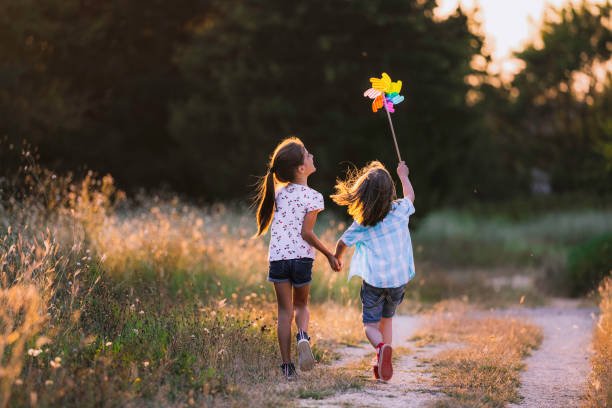3 Nature-Based Ways Kids Can Find Mindfulness.
After school, do your children struggle to do their homework? Or, it’s possible that they have problems calming their thoughts in the evening before going to bed. When they most need it, a feeling of peace may be brought to your children via exposure to nature and mindfulness practices.
According to the Buddhist meditation instructor Mark Coleman of Awake in the Wild, “Nature meditation may help you establish a loving connection with yourself, the land, and the whole web of life.”
We can assist our children to harness the relaxing benefits of nature at sleep, dinnertime, car journeys, and other periods throughout their day by using tactics such as sights, sounds, and storytelling.
The greatest thing is that nature meditation does not necessarily have to be conducted outside in the fresh air; from visualizations to nature sound applications, there are so many methods to experience mindfulness with nature even while sitting in the comfort of your own home.
Sights
It’s amazing how just glancing at photographs of natural settings can give us a sense of fulfillment that’s comparable to really being outside. Recent research discovered that merely gazing at pictures of nature might help lower levels of stress in people.
The participants’ parasympathetic nerve systems, which are responsible for helping us relax, were stimulated when they saw photographs of natural surroundings, which resulted in a reduction in the participants’ levels of stress.
In a separate experiment, this was shown by examining the activity of the brain using magnetic resonance imaging.
The researchers found that the areas of the individuals’ brains connected with empathy and love lighted up whenever they watched images from the natural world.
On the other hand, the areas of the brain linked with dread and anxiety were active when they saw images of metropolitan settings.
Taking in natural scenery may help our children cultivate mindfulness in a number of different ways, including the following:
1 | Get outdoors
Enjoy bright starry nights, rainbows, sunsets, and sunrises by traveling to zoos, mountains, woods, hiking trails, beaches, waterfalls, botanical gardens, canyons, and caverns.
Take photographs with your children to help them remember these special times and give them something they can look at whenever they need to unwind.
2 | Study the natural world through the lens of a variety of artistic mediums
Videos, still images, slide displays, and even movies shown in 3D or 4D in an IMAX theater might fall under this category. Check out “Shots of Awe” by Jason Silva and “Gratitude Revealed” by Louie Schwartzberg, both of which are documentaries about the natural world.
3 | Engage in meditations that include visualizing sceneries from nature
For instance, the Over the Rainbow Breathing meditation advises children to quietly or aloud recite a positive affirmation after visualizing a rainbow and breathing in each hue of the rainbow as they do so.
Put a fish tank in your kid’s room. They’ll love it!
They will enjoy nothing more than dozing off in bed while listening to and watching fish swim about in a tank. Your kid will appreciate having something peaceful and calming to look at as they are attempting to go off to sleep, such as a vibrant fish tank that contributes to the natural feel of the room.
Sounds
People have known for hundreds of years that listening to the sounds of nature may make us feel better emotionally and calm our spirit. Walking through the El Yunque rainforest in Puerto Rico and concentrating on the gushing of the stream below; hearing the lovely birds chirping in an arboretum that we visited,
and remembering how happy and relaxed I felt while sitting on the beach and getting lost in the pattern of the crashing waves are all examples that come to mind when I think about those experiences.
However, until fairly recently, scientists were unable to explain why the sounds of nature had such a significant impact on both our bodies and our thoughts.
A team of investigators from Brighton and Sussex Medical School (BSMS) in England recently made the startling discovery that these noises may really change the connections in our brain, therefore dampening the natural fight-or-flight response that is present in our bodies.
Their research, which was just published in the journal “Scientific Reports,” is the first of its kind to make use of brain scans, heart-rate monitors, and behavioral trials in order to discover a real physiological explanation for how the sounds of nature affect us.
Researchers found that activity in the brain’s default mode network, such as mind wandering and task-free states of wakefulness, varied depending on the background sounds that were being played while they observed adults who underwent functional MRI scans while listening to various soundscapes of natural or artificial environments.
This was discovered after observing adults who underwent functional MRI scans while listening to various soundscapes of natural or artificial environments.
Listening to manufactured noises, for instance, was connected with inwardly focused thought, such as being worried, but listening to sounds of nature was associated with more externally focused attention, which is more relaxing.
The data on heart rate also demonstrated that exposure to the sounds of nature led to a reduction in the body’s sympathetic response, which is responsible for the “fight or flight” reaction, and an increase in the parasympathetic response, which is responsible for the relaxation response in the body.
The relaxing influence that different sounds of nature have on people might vary greatly. The most pleasant sounds are those that make us feel as if we are in a natural setting and that imitate the natural cycles of an ecosystem, such as a forest.
According to recent research, it has something to do with the way in which our brain processes various sounds.
Sounds of water, such as crashing waves, the pitter-patter of raindrops, or the rush of a running river, are highly relaxing because of the gradual, rhythmic whooshing noises that they produce. Loud chirping and croaking will not provide the same peaceful sentiments as the sounds of water.
Children may have a greater sense of mindfulness if they listen to the calming sounds of nature. Request that they take a seat, shut their eyes and relax as they listen to the soothing sounds that they will hear.
In order for them to experience the full impact, teach them how to employ skills of visualization as well as their own imagination. With the help of the following tools, we are able to bring the calming sounds of nature into our everyday lives:
1 | CDs and applications specializing in nature meditation
There is an entire business devoted to the production and distribution of music intended for relaxation. You have the option of selecting from a selection that was developed expressly for children or that is concentrated on the various types of sounds that are included.
Experiment with a few different varieties to find out which one your children like the most. Some of them have music in addition to the sounds of nature, while others feature just the sounds of nature, such as the sound of running water or birds tweeting.
2 | Make your own recordings.
Bring a recording device with you for a hike in the woods, a visit to the beach, or any other outing that takes place in the natural environment. Record those soothing sounds so you may listen to them again later.
3 | A water feature located within
One of the neighborhood spas close to where I live has a relaxation area that has a rock-lined wall that is adorned with a waterfall that was created artificially. You may like the idea of installing a little waterfall in your house.
Stories
Poetry has always been able to captivate its audience and move them to think about and comprehend the world around them in more profound ways.
Poetry has been utilized by many people who have a connection to the natural world to express their feelings about that relationship.
It is possible for us to instill a feeling of wonder and reverence for the natural world in our children by reading them poems and tales that are rich in imagery and taking them away from their ordinary surroundings and positioning them, for example, on top of a majestic mountain.
It is possible to experience a wide range of potent and beneficial feelings, such as wonder and relaxation, when we are exposed to the breathtaking splendor and boundless scope of nature, even if just via the written word on a piece of paper. Give these activities a go with your children:
1 | Library
Have some fun reading various books that are available at the library and are renowned to have vivid depictions of the natural world.
3 | Keeping a Journal
Encourage your children to keep a diary of their thoughts and feelings after seeing a breathtaking natural setting like a beach or a botanical garden. This will allow them to reflect on their experiences and draw inspiration for future mindful moments from their writings.
2 | Poetry
Your children should be exposed to a range of nature-inspired poems, and you should encourage them to compose their own. Robert Frost, Alfred Lord Tennyson, William Wordsworth, and P.B. Shelly are only a few of the most well-known names in the history of nature poetry. John Keats is another.
How To Beat Boredom As A Parent
How To Persuade Your Spouse To Help
How To Turn On The Most Important Attraction Mechanism?
Why Do 80% Of The Seduction Tips Fail?




